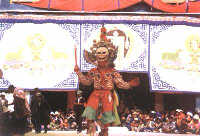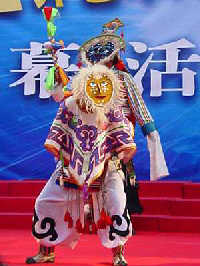|
Tibetan Opera: 'Living Fossil' of Tibetan Culture
( 2005-10-17 )
  Lavish, flamboyant, and over the top Lavish, flamboyant, and over the top
Traditionally, the theater for Tibetan Opera was an open circular space sheltered by a canopy, with the stage defined by a magical circle and central altar.
Over the centuries, the opera has formed a three-part stage process.
In the prelude, known as "Wenbadun," Wenba men in blue masks, two Jialu men, and several fairies take the stage to perform religious rituals and songs and dances, and introduce the actors and actresses.
Next, a narrator explains the plot, section by section, as the opera is being performed, episode by episode. In the absence of a realistic setting and props, the narrator's words must conjure up the stage effects in the audience's imagination. Two musicians -- a drummer and a cymbalist -- sit on the side of the stage. An idiosyncratic drumbeat, accompanied by a specific dance step, identifies each character.
 The performance ends with a blessing ritual that features a blessing ceremony and is also an occasion for the audience to present hada and donations. The performance ends with a blessing ritual that features a blessing ceremony and is also an occasion for the audience to present hada and donations.
Tibetan Opera costumes are very lavish, with rich brocades and a striking variety of masks and animal motifs. The musical score is created entirely by the drum and cymbals that punctuate every movement, and by the singing actors. The rapidly chanted narration alternates with the sung dialogues repeated in the chorus. The dance movements are refined, exaggerated, and vigorous.
The highlight of Tibetan Opera is the mask. Located on the front of the mask is usually a motif, such as the sun or moon. The actor's role can be identified from the type of mask he or she is wearing. For example, a red mask represents the king; a green, the queen; a yellow, Lamas and deities, and so on.
Tibetan Opera call for skills in singing, dancing, elocution and the martial arts. Historical pageantry, myth, and magic are woven together with earthly humor and scenes from the daily lives of ordinary people. The primitive simplicity and vigor demonstrated in the singing and dancing is effectively reflected in the typical Tibetan landscape backdrops.
 Today, changes have taken place in the structure, singing, dancing, masks, and stage format of Tibetan Opera; an orchestra, backdrop, lighting, and make-up have also been added. Tibetan opera is now also performed both in the open air and indoors. Today, changes have taken place in the structure, singing, dancing, masks, and stage format of Tibetan Opera; an orchestra, backdrop, lighting, and make-up have also been added. Tibetan opera is now also performed both in the open air and indoors.
 Four schools and eight great classical operas Four schools and eight great classical operas
Today, Tibetan Opera has four schools:
1. The Goinba School
The Goinba School, originating in Ngamring and Lhaze counties of Southwest China's Tibet Autonomous Region, features high-pitched and sonorous singing, mixed with songs and dances from the Doi area, and traditional acrobatics.
2. The Gyanggar School
The Gyanggar School is popular in Rinbung, Gyangze, and Xigaze, and is characterized by an ancient, rugged, and solemn style derived from Lamaism.
|

